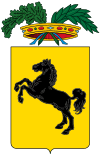Afragola
| Afragola | ||
|---|---|---|
| Comune | ||
| Comune di Afragola | ||
 Afragola City Hall | ||
| ||
 Afragola Location of Afragola in Italy | ||
| Coordinates: 40°55′N 14°19′E / 40.917°N 14.317°ECoordinates: 40°55′N 14°19′E / 40.917°N 14.317°E | ||
| Country | Italy | |
| Region | Campania | |
| Metropolitan city | Naples (NA) | |
| Government | ||
| • Mayor | Claudio Grillo | |
| Area | ||
| • Total | 17.9 km2 (6.9 sq mi) | |
| Elevation | 43 m (141 ft) | |
| Population (28 February 2017) | ||
| • Total | 64,470 | |
| • Density | 3,600/km2 (9,300/sq mi) | |
| Demonym(s) | Afragolesi | |
| Time zone | UTC+1 (CET) | |
| • Summer (DST) | UTC+2 (CEST) | |
| Postal code | 80021 | |
| Dialing code | 081 | |
| Patron saint | St. Anthony of Padua | |
| Saint day | June 13 | |
| Website | Official website | |
Afragola (Italian pronunciation: [afraˈɡoːla]; Neapolitan: Afravóla, Afragolese dialect: Afraóra [afraˈoːrə]) is a city and comune in the Metropolitan City of Naples, in Italy. It is one of the 100 largest Italian cities (the ones that have a population of more than 63,000 inhabitants).
The communal territory, measuring 18 square kilometres (7 square miles), borders the municipalities of Acerra, Casalnuovo di Napoli, Caivano, Cardito and Casoria, forming a single metropolitan area of around 100,000 inhabitants. The comune of Afragola is one of the most densely populated of the country.
History
The are of modern Afragola was already settled in ancient times by the Samnites. Older remains, belonging to an early Bronze Age settlement buried by a Vesuvius eruption in the 19th century BC, were found in 2005.
he town was founded only in the Middle Ages: according to a tradition now recognized as false[1], in 1140 by Roger II of Sicily, who assigned the land to its veterans. It is more likely that the city stemmed from the merger of several villages and churches already existing here. The territory was originally held by the archbishops of Naples, but from 1576 it was directly subjected, as an autonomous community, to the Kings of Naples.
Main sights
- Baroque sanctuary-basilica of St. Anthony's sanctuary-basilica. It was begun in 1633 and has a nave with two aisles, internally decorated with marbles. The bell tower was constructed from 1590.
- The castle, documented from 1495, was likely built from around 1420. According to the tradition, it was a residence of queen Joanna II of Naples. It currently houses a childhood school.
- Santa Maria d'Ajello : Church founded in 1190. It houses works by Giovan Angelo Criscuolo, Alessandro Viola (1695) and Angelo Mozzillo.
- San Marco in Sylvis Church built around 1179. On its external wall is a slab on which, according to the legend, once sat both St. Mark and San Gennaro.
- San Marco all'Olmo: Church built in 1615.
- Palazzo Migliore (17th century)
- San Giorgio Martire: Parish church built in 1695-1702
Transportation
A commercial station on the Rome-Naples high-speed railway, designed by Zaha Hadid, is being built at Afragola.[2] The current station of Casoria-Afragola is on the Rome-Formia-Naples mainline.
The public bus transport is managed by CTP, serving internal connections as well as to the nearby communes of Caserta, Naples and others.
Criminality and social issues
Afragola is the seat of one of the largest camorra clans of the area, that led by Anna Mazza. In 1999 and 2005, the communal council was disbanded by rule of the President of Italian Republic due to mafia allegiance of some of its members.[3]
Along with most of the nearby communes, Afragola also suffers of high pollution rates, as well as a high unemployment rate; unreported employment is also widespread.[4]
References
- ↑ Capasso, Gaetano. Afragola, Dieci secoli di storia comunale. Aspetti e Problemi. Athena Mediterranea.
- ↑ Marco Rinaldi (2014-01-16). "Station Afragola by Zaha Hadid". Aasarchitecture.com. Retrieved 2016-03-09.
- ↑ "le decisioni del Tar". La Repubblica. Retrieved June 11, 2013.
- ↑ "I cantieri della vergogna". Archivio.rassegna.it. Retrieved June 11, 2013.
External links
| Wikivoyage has a travel guide for Afragola. |
- Official website (in Italian)


